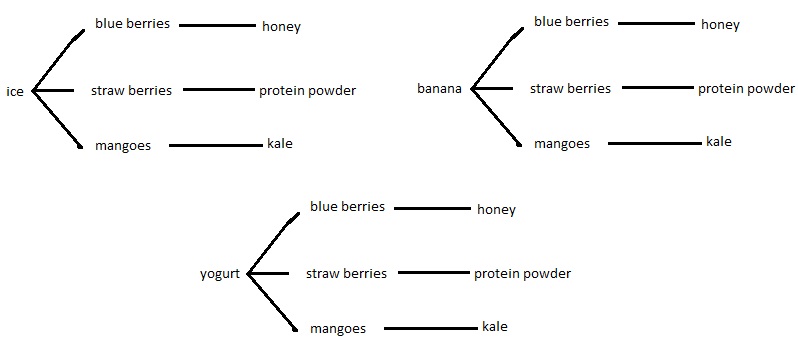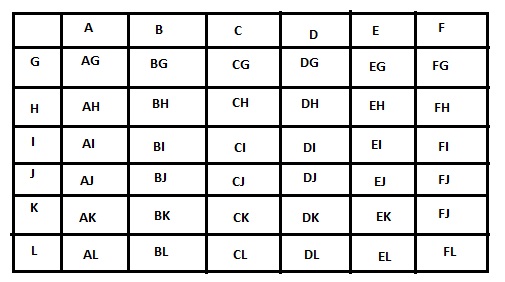This handy Spectrum Math Grade 7 Answer Key Chapter 7 Lesson 7.8 Problem Solving provides detailed answers for the workbook questions
Spectrum Math Grade 7 Chapter 7 Lesson 7.8 Problem Solving Answers Key
Solve each problem. Use either the Fundamental Counting Principle, a tree diagram, or a table to solve each problem. Show your work.
Question 1.
Stephen flips a coin and pulls a marble from a bag 1. which contains equal amounts of red, green, yellow, and blue marbles. How many outcomes are possible?
There are ____________ possible outcomes.
Which strategy did you use to solve this problem?
Answer:
8,
Explanation:
By using the strategy of fundamental counting principle given that no of outcomes by first event flip a coin is 2 and no of outcomes for second event marbles are 4 so, no of possible outcomes are 2 x 4 =8.
Question 2.
Julie is playing a game. She has a bag with cards numbered I-10 and another bag with red and yellow bouncy balls. She pulls a number card out of one bag and a bouncy ball out of another bag. How many outcomes are possible?
There are ____________ possible outcomes.
Which strategy did you use to solve this problem?
Answer:
20,
Explanation:
By using the strategy of fundament principle number of outcomes for 1-10 numbered is 10 and no of outcomes in another bag is 2 so, number of possible outcomes 10 x 2 = 20.
Question 3.
At the sandwich shop, Nick can order a sandwich on a sub roll, wheat bread, or a Kaiser roll. He can have ham, turkey, or roast beef. Then, he can add cheese, lettuce, or pickles. What is the probability that he will have a sandwich that is both on wheat bread and made with ham?
There is a ____________ chance of his ordering a sandwich with both wheat bread and ham.
Which strategy did you use to solve this problem?
Answer:
\(\frac{1}{9}\),
Explanation:

so ,number of outcomes are 18 therefore the probability that have sandwich that is both wheat bread and ham is 2/18=1/9.
Question 4.
Jeff has a deck of cards and a coin. What is the chance that he will pull a 10 from the deck of cards and land on heads?
There is a ____________ chance of Jeff pulling a 10 and flipping heads at the same time?
Which strategy did you use to solve this problem?
Answer:
\(\frac{1}{26}\),
Explanation:
Given number of outcomes for deck of cards are 52 and number of odds of outcomes that pull from deck and land on heads is 2 so, therefore the chance of pulling and flipping heads is 2/52=1/26.
Solve each problem. Use the Fundamental Counting Principle, a tree diagram, or a table to solve each problem. Show your work.
Question 1.
Mark and his friends are playing a game. They take turns pulling a number 1-5 out of one bag and a number 6-10 out of another bag. They keep their score and then put the numbers back. The first person to get a sum of 15 wins. What is the probability of winning on each turn?
There is a _______________ chance of winning the game on each turn.
Which strategy did you use to solve this problem?
Answer:
\(\frac{1}{25}\),
Explanation:

The strategy used to solve is table method so, the first person to get sum of 15 wins is 1 and total number of outcomes are 25 therefore 1/25 is the chance of winning the game on each turn.
Question 2.
Mr. Roberts’ son has a set of blocks that are made up of 12 different shapes and 4 different colors. Every shape comes in every color. How many blocks are in the set?
There are ______________ blocks in the set.
Which strategy did you use to solve this problem?
Answer:
48 blocks in the set ,
Explanation:
The strategy used to solve this is fundamental counting principle so, number of odds of different shapes is 12 and number of odds of different colors is 4 so, number of blocks in the set are 12 x 4 = 48.
Question 3.
Sarah is at the smoothie shop. She can choose a base of ice, banana, or yogurt. She can add blueberries, strawberries, or mangoes. Then, she can add honey, protein powder, or kale. How many combinations are possible?
Sarah has _______________ combinations to choose from.
Which strategy did you use to solve this problem?
Answer:
Sarah has 27 combinations to choose from,
Explanation:

To solve this strategy used a tree method as that number of combinations choose a ice, banana and yogurt are 9 x 3 = 27.
Question 4.
A box of chocolates is half milk chocolate and half dark chocolate. Each kind of chocolate is filled with coconut, caramel, nuts, or cherries. What is the probability of choosing a candy that is made of dark chocolate and cherries?
There is a ________________ chance of choosing a candy made of dark chocolate and cherries.
Which strategy did you use to solve this problem?
Answer:
\(\frac{1}{8}\),
Explanation:
Given box of chocolates contains milk chocolate and dark chocolate so, total number of outcomes are 8 therefore the probability of choosing dark chocolate and cherries are (p)=1/8.
Solve each problem. Use the Fundamental Counting Principle, a tree diagram, or a table to solve each problem. Show your work.
Question 1.
A cube with six sides has the letters A-F on it. A spinner has the letters G-L on it. How many letter combinations are there when the cube is rolled and the spinner is spun?
There are ____________________ possible letter combinations.
Which strategy did you use to solve this problem?
Answer:
36 possible letter combinations ,
Explanation:

To solve this strategy used a table method so, number of possible letter combinations are 36.
Question 2.
A bakery has both donuts and bagels. They are each available in blueberry, chocolate, and plain. What is the probability of choosing at random a blueberry bagel?
There is a ____________________ chance of randomly choosing a blueberry bagel.
Which strategy did you use to solve this problem?
Answer:
\(\frac{1}{6}\),
Explanation:
Given that number of outcomes are 6 and number of item is 1 that is blueberry bagel so, the probability (p) of choosing a blueberry bagel is 1/6.
Question 3.
Customers have a choice of thin crust, hand-tossed crust, or deep dish pizzas. They can add a pesto, tomato, or olive oil base. Finally, they can add pepperoni, mushrooms, or onions. What is the probability that a customer will order o pizza with both thin crust and mushrooms?
There ¡s a ____________________ chance that a customer will order a pizza with both thin crust and mush rooms.
Which strategy did you use to solve this problem?
Answer:
\(\frac{1}{9}\),
Explanation:
Given that number of outcomes are 3 x 3= 9 so, number of favorable outcomes that thin crust and mushroom is 1 therefore the probability (p) is 1/9.
Question 4.
Katie is trying to decide where to go on vacation. She has narrowed it down to Spain, Hawaii, and Puerto Rico. She can take between 7 and 10 days for her trip. How many options does she have?
Katie has ____________________ choices for her vacation.
Which strategy did you use to solve this problem?
Answer:
12 choices had Katie for vocation,
Explanation:

The strategy used to solve this is tree method number of choices for Katie had for her vocation are 12.